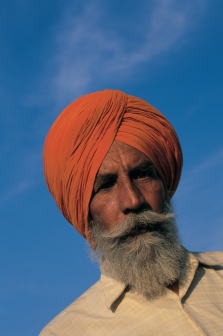
New Delhi, May 22 (IANS) — It was naturally a proud day for every Sikh, a defining moment in the young religion’s history.
But despite their numerical minority in overwhelmingly Hindu India, the Sikhs are a high profile community known for their enterprise, grit and courage — qualities they say are closely linked to their religion.
It was Guru Nanak (1469-1539) who founded the Sikh religion some 500 years ago by seeking to combine Hindu and Muslim elements in a single religious creed.
“Realization of Truth is higher than all else. Higher still is Truthful Living,” he exhorted his followers.
Guru Nanak’s territory was the Punjab, a farm rich area that today is divided between India and Pakistan.
Within a short period, Guru Nanak – a saintly man – came to attract hundreds of thousands, and the religion began to take roots.
Succeeding Guru Nanak were nine other “gurus”, the last of whom, Guru Gobind Singh, gave the Sikhs the identity by which they can be recognised even today.
There are some 22 million Sikhs worldwide – over 19 million in India, heavily concentrated in Punjab but found all over the country. They also live in large numbers in Britain, Canada, East Africa, Malaysia and the US.
Sikhs are a very recognisable community, with the men sporting turbans and beards – often flowing, sometimes tied and sometimes even clipped, even though the religion forbids this.
When baptised, Sikhs take a vow not to cut their hair as well as not to smoke or drink alcohol.
They also keep the five K’s: “Kesh” (long hair), “Kangha” (comb tucked in the hair), “Kara” (steel bracelet on the right wrist), “Kachha” (loose underwear) and “Kirpan” (dagger).
Amritsar in Punjab is to the Sikhs what the Vatican is to Roman Catholics. Amritsar is home to the Golden Temple, Sikhism’s holiest shrine. Ram Das, the fourth of the 10 Sikh gurus who lived in the 16th century, founded it.
Sikh shrines are known as Gurdwara, or Gateway to god. They are central to the existence of every Sikh.
In Gurdwaras, Sikhs prostrate before the Granth Sahib, the Sikh bible, and collect a serving of “Kara Prasad” or sacrament.
More elaborate rituals are performed on occasions like Baisakhi, the second most important festival for Sikhs after Guru Nanak’s birthday.
The Gurudwara is also the venue of a unique Sikh ritual called “langar” or community meal. Twice a day, anyone, regardless of his religion, can walk in and partake of a vegetarian meal for free.
Working Sikhs, be they salaried or self-employed, make it a point to contribute a share of their earnings to the Gurudwara every month.
Arjun Dev, the fifth guru who reigned 1581-1606, gave Sikhism the Granth Sahib, which contains hymns of Sikh gurus as well as those of Hindu and Muslim saints such as Kabir.
Sikhs attach great importance to the reading of the Granth. Ordinarily, the book is opened at any page and the reading starts with any passage.
Sometimes the reading of the whole book is undertaken as “Saptah Path” or cover-to-cover reading in seven days or as “Akhand Path”, uninterrupted reading of the book in 48 hours.
To the 10th guru, Gobind Singh, who reigned 1675-1708, goes the distinction of founding the “Khalsa”, or the army of the pure, to defend the religion.
Baisakhi, celebrated as a harvest festival in Punjab, also commemorates the founding of the Khalsa.
The Sikhs have undergone four traumatic periods in their history.
The first began in 1708 with the assassination by Mughal rulers of Gobind Singh and lasted till 1799, when, under Maharaja Ranjit Singh (1780-1839), they laid claim to a large part of northwest India.
After Ranjit Sing’s death, his Sikh kingdom disintegrated. British colonial rulers moved into the Punjab, leading to the Sikh Wars of 1845-46 and 1848-49.
The Sikhs were defeated and the British annexed the Punjab. Sikhism did not recover until the early 20th century.
Then, when the Indian subcontinent was partitioned in 1947, west Punjab became Pakistani territory and east Punjab a part of India. Large numbers of Sikhs were slaughtered in Pakistan’s Punjab. Some 2.5 million Sikh men, women and children moved from Pakistan into India.
In 1984, some 3,000 Sikhs were killed following the assassination of then prime minister Indira Gandhi by her Sikh bodyguards.
The community is highly respected, and it has contributed enormously, quite disproportionate to its numbers, in almost every field in India. Manmohan Singh, a devout Sikh, is a member of this very proud community.
© Copyright 2001-2003 IANS India Private Limited, New Delhi. Posted on Religioscope with permission.